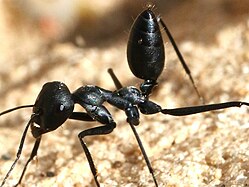
Back Gaster German Γαστήρ (έντομα) Greek Gáster Spanish شکمچه Persian Abdomen (anatomie des insectes) French Gáster Galician Gaster NB Gaster Polish Gaster (anatomia insectelor) Romanian

The gaster is the bulbous posterior portion of the metasoma found in hymenopterans of the suborder Apocrita (bees, wasps and ants). This begins with abdominal segment III on most ants, but some make a constricted postpetiole out of segment III, in which case the gaster begins with abdominal segment IV.[1][2]
Certain ants in the genus Cataglyphis, including Cataglyphis bicolor and Cataglyphis fortis, have a cubiform petiole that allows them to decrease their inertia (and therefore increase their speed) by raising their gaster into an upright position.[3]
-
Cataglyphis nigra with raised gaster
- ^ Cite error: The named reference
antinfowas invoked but never defined (see the help page). - ^ Cite error: The named reference
desertantswas invoked but never defined (see the help page). - ^ McMeeking, Robert M .; Arzt, Eduard; Wehner, Rüdiger (July 2011). "Cataglyphis desert ants improve their mobility by raising the gaster". Journal of Theoretical Biology. 297: 17–25. doi:10.1016/j.jtbi.2011.12.003. PMID 22178639.
© MMXXIII Rich X Search. We shall prevail. All rights reserved. Rich X Search
